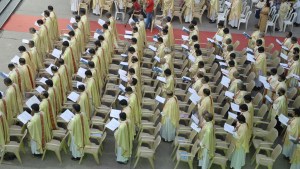At times priests or bishops will refer to the “curia” in the Catholic Church. What does it mean?
Some believe that the word “curia” is derived from the Latin word coviria, meaning a “gathering of men.” In the Roman Empire the word became associated with the Roman senate or other meetings that involved high ranking officials that came together to make decisions.
Since the Catholic Church was born within the Roman Empire and was firmly planted in Rome, many of the same terms were adopted. Not surprisingly, “curia” in Catholic usage has essentially the same definition. According to the Catholic Encyclopedia, “Strictly speaking, the ensemble of departments or ministries which assist the sovereign pontiff in the government of the Universal Church. These are the Roman Congregations, the tribunals, and the offices of Curia (Ufficii di Curia).”

Read more:
What is a monsignor in the Catholic Church?
While primary curia members are involved with the government of the Universal Church, the term has also been used on the local level when referring to “Diocesesan Curia.” This refers to members involved in the government and administration of the local Diocese, which includes both men and women, priests and laity. They assist the bishop in making important decisions and also act as resources for local Catholics (such as the director of the Marriage and Family Life Office, for example).
The term is an ancient one, recalling the Roman heritage of the Catholic Church, and dates back thousands of years.

Read more:
What is a diocese?

